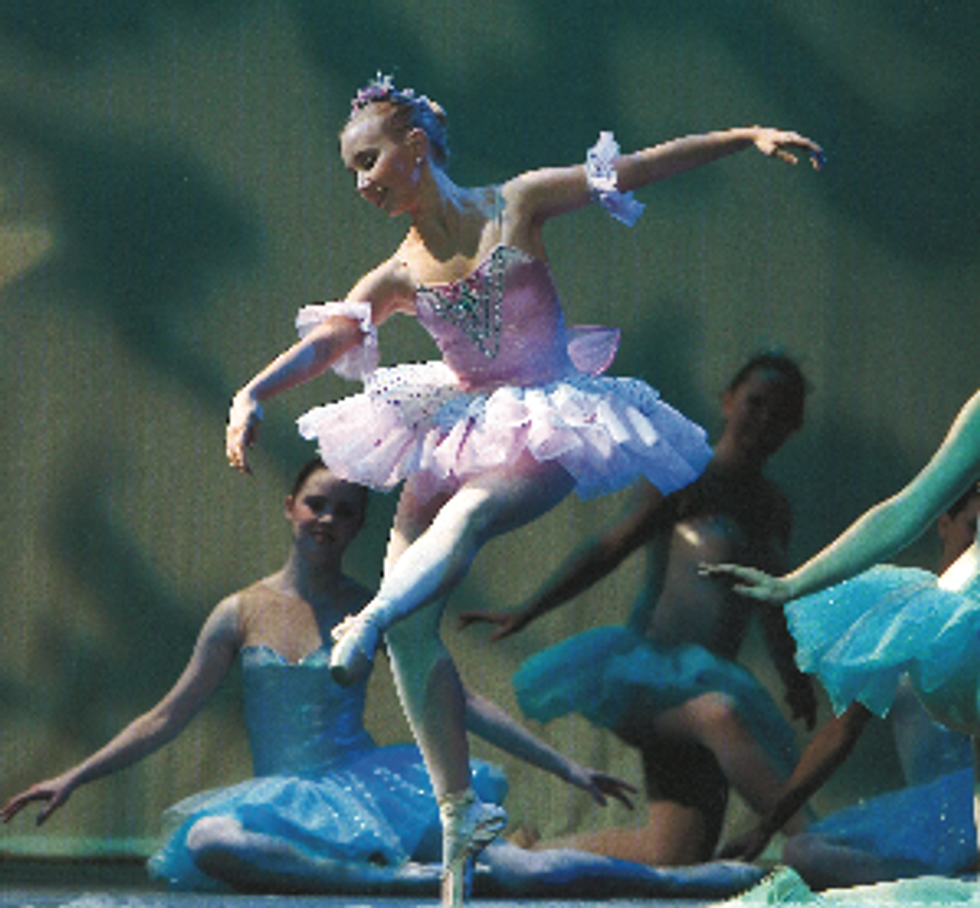Starving for Perfection

Sarah continued dancing throughout her struggles with eating disorders. Photo by Randy Gay.
When I was 10 years old, I only knew one thing about the professional dance world: ballerinas weren’t fat. Every day before class, I would enter the studio and study my reflection in the mirror, wondering if my tummy bulged too much. Sucking in my stomach, I’d vow that I’d become a perfect ballerina—no matter the cost. This early commitment to perfection planted the seeds for what would soon become a life-threatening battle with calories, the scale and my own reflection.
At 14, after six years of homeschooling to accommodate my rigorous training schedule at a pre-professional ballet academy, I made a rocky transition to a fine arts high school in my hometown of San Antonio, TX.
One day at the start of my second semester, after bursting into tears over the size of my thighs during a ballet class, I decided to lose weight—a lot of it. Calorie counting became my new hobby, and I added hours of walking and running to my already intense 30 hours of weekly dancing. As the school year wound down, my mom started commenting on the fact that I barely ate anymore, serving me extra portions and encouraging me to rest rather than work out. I found ways to throw away my food and make it look like I was eating during family meals. By the end of that summer, I’d dropped almost 20 pounds—a dramatic amount of weight on my petite 5-foot-2-inch frame.
At the beginning of my sophomore year, I started experiencing intense lower back pain during every dance class. An MRI revealed that when I moved into and out of an arabesque, instead of returning to normal alignment, my vertebrae remained twisted. I later learned that malnutrition likely contributed to my injury. Thankfully it wasn’t severe enough to prevent me from dancing, but it did catch the attention of my dance teachers at school. They asked about my sudden injury and unnecessary weight-loss, but they didn’t press the matter further after I assured them I was eating properly. The pain in my back alarmed me, but I didn’t dare ask for help. After all, I felt like I had everything under control. I thought if I just ate a little more it would be okay.
But it wasn’t that easy. My attempts at normal eating backfired and I began a steady routine of bingeing and starving. My weight eventually stabilized, but my mind didn’t. Over the next two years, I performed in dozens of shows, attended elite summer dance programs and joined academic honor societies. Instead of feeling pleased with my success, I obsessed over how I could be better, thinner and happier. Food became something I had to earn rather than something I needed.
Frustrated that my behavior was no longer yielding the weight-loss results I craved, I adapted new rules about what I could eat and when. My skin grew pale and dark circles hung under my eyes. Clumps of hair fell out of my bun, and though I was tired all the time, I stayed up most nights doing crunches and thinking about what I would and wouldn’t eat the next day.
I became irritable, snapping at my parents and withdrawing from friends. It became harder to maintain my usual straight A’s, as I spent classes mentally counting calories. Every muscle ached and I could barely muster the energy to tendu, let alone power through a whole class. Dancing—the one thing that had always brought me joy—was now almost too painful to do.
I’d been crash dieting for two years, but because my weight wasn’t much lower than the norm for many professional ballet dancers, most people had no idea how ill I was. Then, in April 2006, my dance teacher approached me after rehearsal and commented on my weight. She warned me that if I continued abusing my body, I might have to stop dancing forever. Her words gave me the courage to admit, reluctantly, that I had a problem. Telling my parents that I needed help was one of the hardest things I’ve ever done. They took me to the doctor, who diagnosed me with anorexia nervosa, and I began my journey down the difficult road of recovery.
At first, I was scared to let go of my eating disorder. It was so much a part of my identity that I didn’t know how I could function without it. I also struggled to find a therapist who was trained to treat people with eating disorders—many I visited told me to “just eat!” Eventually, I found a sports psychologist and a dietician who helped me learn to feed myself again.
About a month after I began treatment, I experienced a turning point. I booked my first professional dance job at a theme park and realized that I couldn’t perform two or three shows a day without fueling my body. I owed it to my employer and my fellow dancers—as well as myself—to get healthy. I spent the summer going to therapy and dietetic appointments in the morning, and rehearsed and performed in the afternoons and evenings. Gradually, I learned to listen to my body, enjoy food and delight in dancing.
While I’ve made a full recovery from anorexia, a few effects of my disease still linger. Back pain from that early injury still makes an arabesque more difficult than it should be. Because my disordered eating habits began when I was young, I suffered from primary amenorrhea, meaning I didn’t have a menstrual cycle until I was 18. I’m now discovering that this may affect my chances of having a child. I feel blessed to have received treatment before my disease damaged any vital organs—an effect of anorexia that can be fatal.
These problems remind me every day that our bodies are breakable gifts meant to be handled with care. There was a time when I couldn’t imagine a life that wasn’t ruled by numbers on a scale. Now that I’m free of anorexia, I’ve danced professionally in NYC, earned a college degree and married the love of my life. Perfection isn’t possible, I’ve learned, but happiness is.
Getting Better
Recovering from an eating disorder takes a lot of courage. If you want to experience a life free from your eating disorder but don’t know where to start, read these tips from Johanna S. Kandel,* a former dancer and current executive director of The Alliance for Eating Disorders Awareness:
Reach out for help.
Having an ally will give you the encouragement you need to get better. Confide in your parents, best friend, counselor or a trustworthy teacher.
Contact an eating disorder organization for referrals to psychologists, therapists and nutritionists who can help you.
The Alliance for Eating Disorders Awareness (allianceforeatingdisorders.com) and the Eating Disorder Referral and Information Center (edreferral.com) are great places to start.
Call two or three professionals in your area and talk with each of them for a few minutes before committing to one.
You’ll be working closely with your therapist and nutritionists throughout your recovery, so it’s important that you’re comfortable with them. If possible, choose someone who has experience treating dancers or athletes.
Relax and take a deep breath.
Remember that recovery doesn’t happen overnight and it won’t be perfect. But people do recover!
*Check out Kandel’s book Life Beyond Your Eating Disorder for more insight about overcoming eating disorders.




